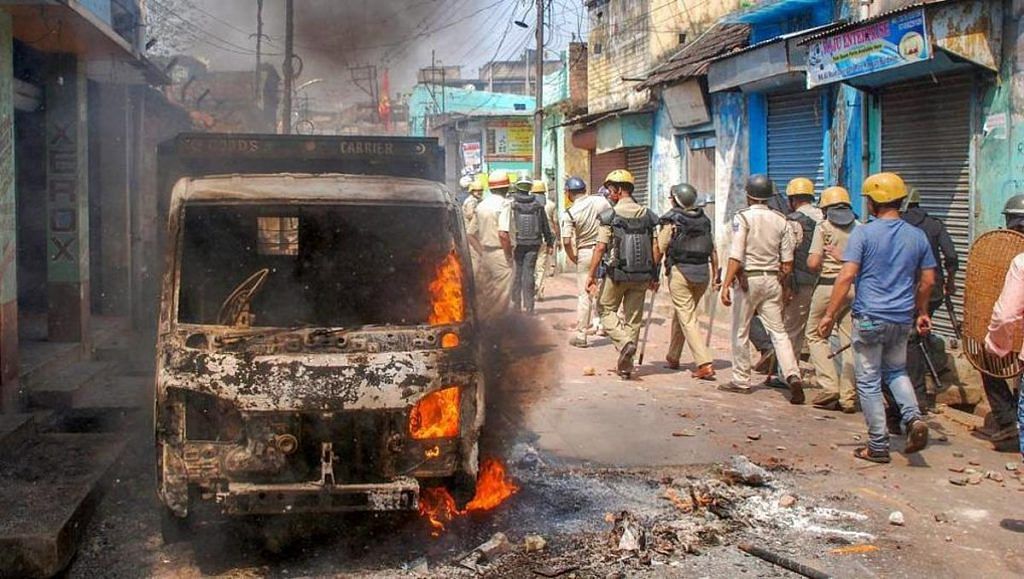People in West Bengal are polarised on the lines of political affiliations and identities.
West Bengal is providing almost a daily staple of violent incidents these days.
The body of a BJP supporter was found hanging from a tree in remote Purulia village; a bomb killed a 7-year old child in a Kolkata suburb; an irate mob of parents attacked a school after a teacher was accused of sexually assaulting a child. Last month, two people were killed in clashes that broke out over appointment of Urdu language teachers at an Islampur school.
The image portrayed is one of West Bengal as a hotbed of violence. In the widespread violence during, before and after the panchayat elections held in May, more than 24 political workers died and hundreds were injured.
Of the total seats in gram panchayat, panchayat samiti and zila parishad, about 34 per cent remained uncontested because armed Trinamool Congress (TMC) activists allegedly restricted opposition candidates from filing their nomination papers. After the poll, TMC factions reportedly fought among themselves for control of the panchayat posts.
Also read: Amit Shah set for Purulia visit in bid to bolster Bengal outreach after BJP workers’ deaths
A complex history
Unlike other states where caste and communal politics often define the nature of violence, West Bengal has predominantly witnessed party violence over the last several decades. People in the state are polarised on the lines of political affiliations and identities. Once a violent incident gets a political colour, it gets wider coverage in the media and is etched in collective memory.
Bengal violence has a complex history, which cannot be explained using a simple binary of ruling party versus the opposition alone. Political violence in West Bengal is tied to the start of the Naxalite movement in 1967. The 1971 India-Pakistan war added a new dimension to that and hundreds of sophisticated small weapons were smuggled across the border into West Bengal that reportedly armed both the underworld and the political parties.
The Left in its heyday is known to have often resorted to violence to subdue the opposition. But it wasn’t a one-sided affair and opposition too (read Congress) resorted to similar tactics. It is common knowledge that both parties had armed goons in their ranks. It is equally well known that after the TMC came to power in 2011, the balance titled in its favour.
First the goons, then the party workers were seen to be leaving the Left and the Congress to join the TMC. As the Left and the Congress weakened, attacks on them reportedly reduced. The turf war now shifted to TMC vs BJP in districts like Paschim Medinipur, Purulia, Birbhum and some parts of North Bengal.
Unemployed youth aligned with the ruling party in both urban and rural areas hoping to get some jobs. The party came to be defined by old and new TMC, often clashing violently over the issue of extorting and extracting money from state-funded projects.
Also read: Purulia killings: RSS-BJP workers under threat in Mamata’s West Bengal or is it orchestrated panic?
The battlefield
Warring political parties in Bengal often end up attacking opponents’ offices and houses. Roopa Ganguly, BJP MP in Rajya Sabha, was allegedly attacked by TMC workers in South-24 Parganas in May 2016. Roopa was returning to Kolkata after meeting some ‘poll-violence’ victims in Kakdwip.
Both the CPM and the BJP are now taking out processions to protest against what they call “ruling party-sponsored violence”. Often, they separately approach the Governor to apprise him of the ground reality in the state. The BJP-ruled Centre through the home ministry, at times, seeks report from the West Bengal government over violence in the state.
Most of these incidents of party violence fall into the following categories: extortion by musclemen of real estate syndicates, illegal coal mining in Raniganj-Asansol industrial belt, and illegal sand mining from river beds. These are the classic cases of war over the resources.
Also read: West Bengal is no longer difficult for the BJP to rise in
The bigger problem
In the absence of major investment in industrial sector in the last 10 years, employment generation has been dismal in formal sectors in the state. There has been a steady migration of unskilled and semi-skilled rural workers to Kerala and other southern states.
Even a legal activity like working in an elected panchayat committee is not free from violence. People with political patronage are clamouring to lay their hands on central government welfare funds.
In an effort to offset the problem of unemployment and low industrial activity, the state has been spending a lot on building roads, new colleges, universities and hospitals in remote areas. To keep the unemployed youth somewhat engaged, the state government started giving annual cash dole of Rs 1-2 lakh to more than 12,000 clubs.
The welfare spending in West Bengal has now become a hunting ground for contesting groups with political patronage to get a piece of the cake. For almost every construction project, a percentage of the estimated cost is reportedly set aside for the local leaders and the underlings of the ruling party – even if the builder has affiliation with the party.
This business of extracting ‘levy’ on the little economic activity in the locality is also leading to clashes within various factions of the ruling party.
There seems to be no end in sight to this vicious circle of political violence in West Bengal.
The author is a journalist and political analyst.
